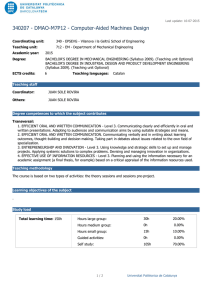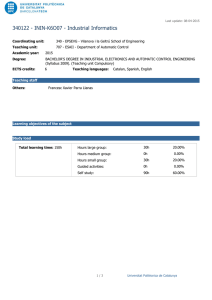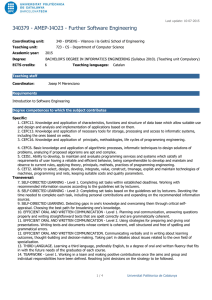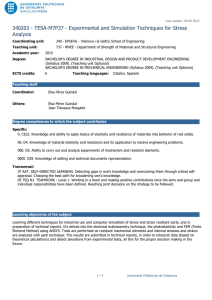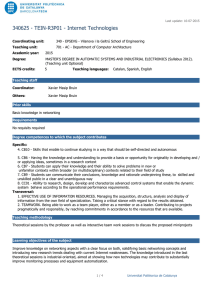230646 - MND - Micro and Nano Electronic Design
advertisement
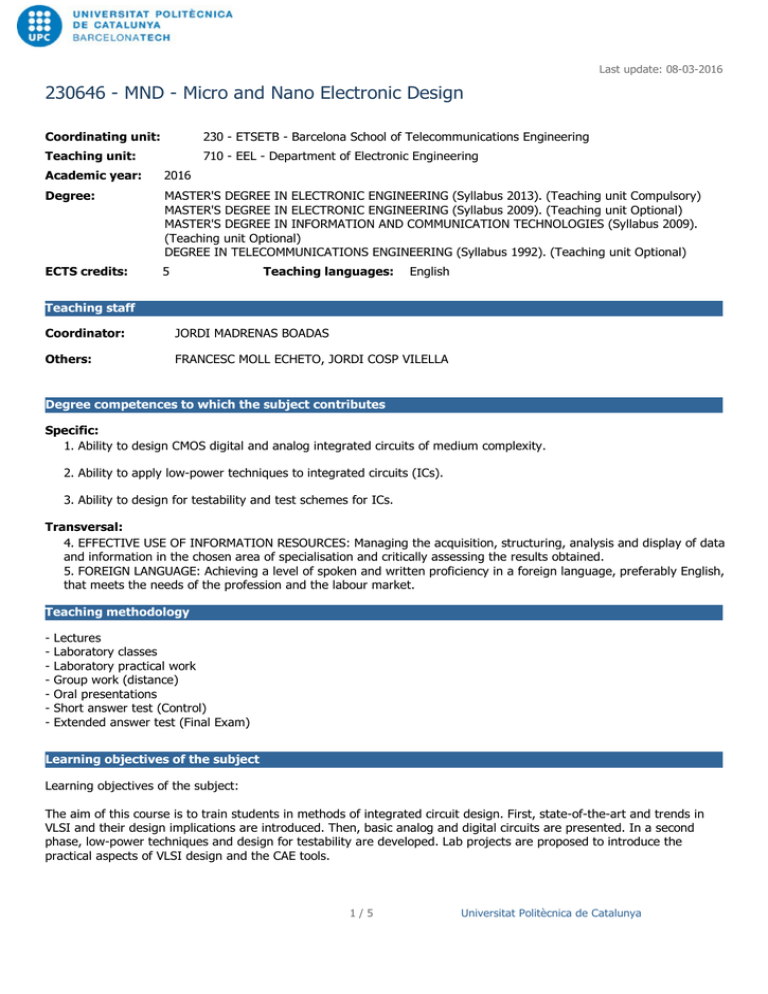
Last update: 08-03-2016 230646 - MND - Micro and Nano Electronic Design Coordinating unit: 230 - ETSETB - Barcelona School of Telecommunications Engineering Teaching unit: 710 - EEL - Department of Electronic Engineering Academic year: 2016 Degree: MASTER'S DEGREE IN ELECTRONIC ENGINEERING (Syllabus 2013). (Teaching unit Compulsory) MASTER'S DEGREE IN ELECTRONIC ENGINEERING (Syllabus 2009). (Teaching unit Optional) MASTER'S DEGREE IN INFORMATION AND COMMUNICATION TECHNOLOGIES (Syllabus 2009). (Teaching unit Optional) DEGREE IN TELECOMMUNICATIONS ENGINEERING (Syllabus 1992). (Teaching unit Optional) ECTS credits: 5 Teaching languages: English Teaching staff Coordinator: JORDI MADRENAS BOADAS Others: FRANCESC MOLL ECHETO, JORDI COSP VILELLA Degree competences to which the subject contributes Specific: 1. Ability to design CMOS digital and analog integrated circuits of medium complexity. 2. Ability to apply low-power techniques to integrated circuits (ICs). 3. Ability to design for testability and test schemes for ICs. Transversal: 4. EFFECTIVE USE OF INFORMATION RESOURCES: Managing the acquisition, structuring, analysis and display of data and information in the chosen area of specialisation and critically assessing the results obtained. 5. FOREIGN LANGUAGE: Achieving a level of spoken and written proficiency in a foreign language, preferably English, that meets the needs of the profession and the labour market. Teaching methodology - Lectures Laboratory classes Laboratory practical work Group work (distance) Oral presentations Short answer test (Control) Extended answer test (Final Exam) Learning objectives of the subject Learning objectives of the subject: The aim of this course is to train students in methods of integrated circuit design. First, state-of-the-art and trends in VLSI and their design implications are introduced. Then, basic analog and digital circuits are presented. In a second phase, low-power techniques and design for testability are developed. Lab projects are proposed to introduce the practical aspects of VLSI design and the CAE tools. 1/5 Universitat Politècnica de Catalunya Last update: 08-03-2016 230646 - MND - Micro and Nano Electronic Design Learning results of the subject: - Ability Ability Ability Ability to to to to understand the evolution of integrated technologies. identify cases and applications suitable for an integrated solution. analyze the characteristics of a mixed-signal integrated circuit. design analog and digital medium-complexity CMOS integrated circuits. Study load Total learning time: 125h Hours large group: 26h 20.80% Hours medium group: 0h 0.00% Hours small group: 13h 10.40% Guided activities: 0h 0.00% Self study: 86h 68.80% 2/5 Universitat Politècnica de Catalunya Last update: 08-03-2016 230646 - MND - Micro and Nano Electronic Design Content 1. Introduction Learning time: 8h Theory classes: 3h Self study : 5h Description: - Structure of static gates. - Manufacturing process. Masks. Layout. - MOSFET models. - State-of-the-art in VLSI. Full-custom and standard-cell design. 2. Basic digital blocks and their characterization Learning time: 20h Theory classes: 7h Laboratory classes: 2h Self study : 11h Description: - The CMOS inverter. The NAND and NOR gates. Pass transistors. Tri-state. Latches. Flip-flops. Memory cells. Layout. - Parasitic elements. Delay definitions. Logical effort. - Power dissipation. 3. Basic analog blocks and their characterization Learning time: 20h Theory classes: 7h Laboratory classes: 2h Self study : 11h Description: - Current sources and mirrors. - Basic amplifier stages. - Voltage and current references. - Matching. Transistor sizing. Layout. - Small-signal model. Parasitics and frequency response. 3/5 Universitat Politècnica de Catalunya Last update: 08-03-2016 230646 - MND - Micro and Nano Electronic Design 4. Practical aspects of VLSI design Learning time: 16h Theory classes: 5h Laboratory classes: 2h Self study : 9h Description: - Buffering. - Power and clock distribution. - Input/output pads. Packaging. - Low-power circuit- and architecture-level techniques. 5. Basic concepts of testing Learning time: 12h Theory classes: 4h Laboratory classes: 2h Self study : 6h Description: - Definitions. Manufacturing test. Defects and faults. - Design for testability. Test coverage. ATPG. - Self-test. Fault tolerance. System-level test. - Design for manufacturability. 6. Laboratory of VLSI design Learning time: 49h Laboratory classes: 5h Self study : 44h Description: - Introduction to CAE tools for VLSI. Layout editor. Electric and logic simulation. Synthesis. Placement & routing. Post-layout simulation. - Design of a transconductor. - Design of a simple digital processor. - Design project: digitally-assisted analog front-end. 4/5 Universitat Politècnica de Catalunya Last update: 08-03-2016 230646 - MND - Micro and Nano Electronic Design Planning of activities LABORATORY Description: - Introduction to CAE tools for VLSI. Design rules, layout, electric and logic simulation, synthesis, placement & routing, backannotation. - Design of a transconductor. - Design of a simple digital processor. - Design project. Front-end and back-end. ORAL PRESENTATION Description: Presentation of a work group. SHORT ANSWER TEST (CONTROL) Description: Mid term control. EXTENDED ANSWER TEST (FINAL EXAMINATION) Description: Final examination. Qualification system Final examination: from 30% to 60% Partial examinations and controls: from 0% to 30% Individual assessments: from 0% to 10% Group assessments: from 0% to 15% Laboratory assessments: from 30% to 50% Bibliography Basic: Weste, N.H.E.; Harris, D.M. CMOS VLSI design: a circuits and systems perspective. 4th ed. Boston: Addison Wesley, 2011. ISBN 9780321547743. Complementary: Lin, Ming-Bo. Introduction to VLSI systems: a logic, circuit, and system perspective. Boca Ratón: CRC Press, 2012. ISBN 9781439868591. Baker, R.J. CMOS circuit design, layout, and simulation. 3rd ed. Hoboken, NJ: IEEE Press : Wiley, 2010. ISBN 9780470881323. 5/5 Universitat Politècnica de Catalunya
